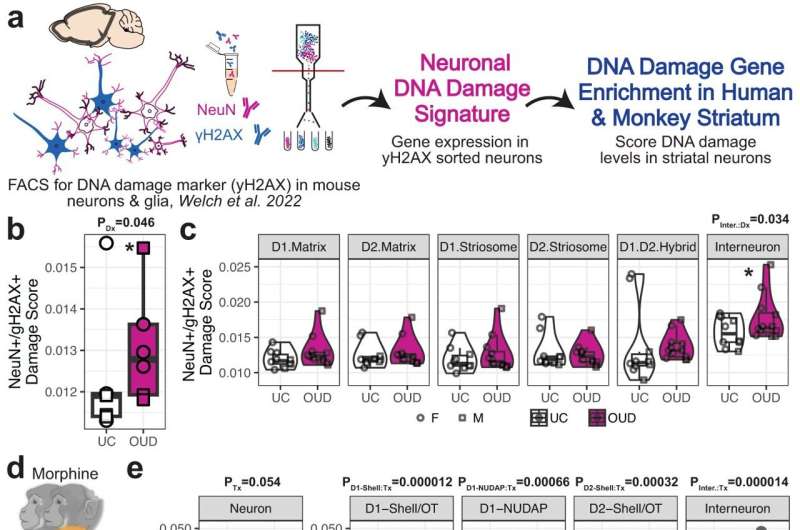This article has been reviewed according to Science X's editorial process and policies. Editors have highlighted the following attributes while ensuring the content's credibility:
fact-checked
trusted source
proofread
Study finds links between chronic opioid use and brain cell, DNA changes

A study led by Ryan W. Logan, Ph.D., professor of psychiatry and neurobiology, has found mutations in key brain cells among individuals with chronic opioid use that could shift how we think about treatment strategies for opioid use disorder.
"One thing we've been trying to think about is how can we heal the brain?" said Dr. Logan. "To be able to do that, you've got to understand what's occurring in the human brain. And the onus is on us then to figure out what is a cause or consequence to opioid use and other disorders."
The study, published in the journal Nature Communications, was conducted by researchers from Carnegie Mellon University, University of Pittsburgh School of Medicine, Boston University Chobanian and Avedisian School of Medicine, Harvard Medical School and University of Rochester School of Medicine, in addition to UMass Chan.
Logan said opioid replacement treatments such as methadone and buprenorphine, which reduce cravings, can be very helpful for treating opioid use disorder. But still, 90 to 95% of people relapse. And with widespread presence of powerful drugs like fentanyl, a relapse could be fatal.
"I don't want to take anything away from those mainstream treatments, but it's not necessarily getting at the causal pathology, the thing that's really driving the subsequent relapse, in the context of stress or environmental instability, and the biology," he said.
The researchers in the current study looked at human postmortem brain tissue from people with opioid use disorder and compared those with brain tissue from people without chronic opioid use, as well as to animal models. They started with the dorsal striatum region of the brain, which Logan said was critical for the transition between occasional drug use to habitual or compulsive drug use.
Using a new approach called single nucleus RNA sequencing, researchers isolated nuclei from the individuals with opioid use disorder and the control individuals. They then did large-scale sequencing or gene expression arrays on the single cells to figure out what had changed.
Among the highlights Logan cited were pro-inflammatory changes that occurred in the striatum of individuals with opioid use disorder that were not only in the microglia, or immune cells of the brain, but also in neurons.
"We have specific hypotheses and questions we're developing as to how these inflammatory signals could spread from glial cells to neurons, and what that might mean for overall functional changes in the cells and circuits, and how we might be able to target them for treatment," said Logan.
The second major finding was that many of the genes reflected changes in brain cell health. Those genes were enriched in pathways involved in DNA damage, Logan said. DNA damage can lead to structural changes in our DNA that ultimately impacts gene function and may be involved in disease. Higher occurrences of DNA damage were found in certain cell types in the striatum, particularly in neurons among individuals with opioid use disorder.
The same type of single nucleus RNA sequencing was performed on animal models that had been exposed to high levels of chronic morphine. Researchers found similar changes in DNA damage markers in animal models that had chronic opioid exposure, which Logan said suggested that chronic opioid administration led to the accumulation of these DNA damage markers.
Logan said this research also offers insight into potentially teasing apart what's happening with genes and proteins in other neurodegenerative diseases such as Alzheimer's.
More information: BaDoi N. Phan et al, Single nuclei transcriptomics in human and non-human primate striatum in opioid use disorder, Nature Communications (2024). DOI: 10.1038/s41467-024-45165-7




















